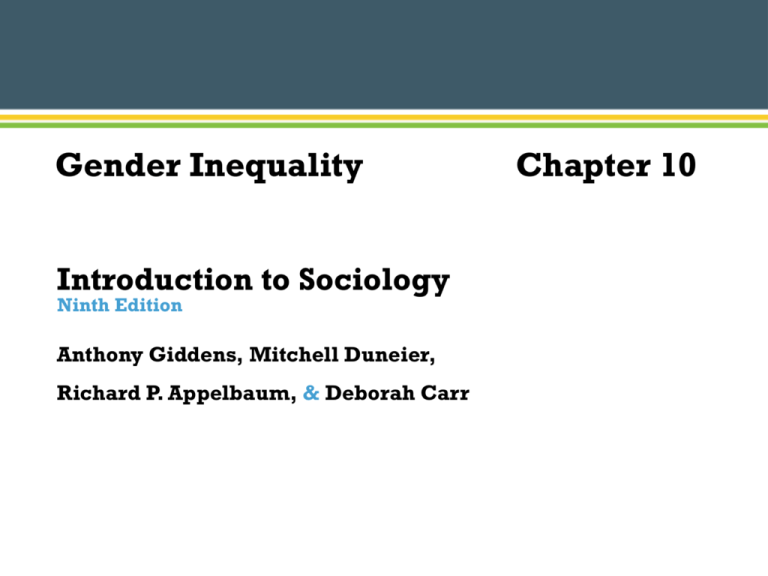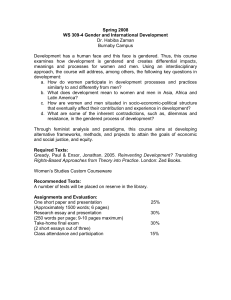Chapter 10 Gender Inequality
advertisement

Gender Inequality Introduction to Sociology Ninth Edition Anthony Giddens, Mitchell Duneier, Richard P. Appelbaum, & Deborah Carr Chapter 10 Gender Inequality • In the year 2012, what percentage of all CEOs of Fortune 1000 companies were women? – (a) 4 percent – (b) 24 percent – (c) 54 percent – (d) 74 percent Copyright © 2014, W.W. Norton & Company 2 Learning Objectives • Basic Concepts – Understand the ways that differences between women and men reflect biological factors, sociocultural influences, and the complex interplay between the two • Sociological Theories of Gender Inequalities – Recognize and contrast competing explanations for gender inequality – Learn some feminist theories about gender equality Copyright © 2014, W.W. Norton & Company 3 Learning Objectives • Research on Gender Today: Documenting and Understanding Gendered Inequalities – Learn the forms that both between and within-gender inequalities take – Understand the ways in which women worldwide experience economic and political inequality • Unanswered Questions: Why do Gendered Inequalities Persist? – Learn about gender-based inequalities in the workplace and violence against women Copyright © 2014, W.W. Norton & Company 4 Basic Concepts • Sex – The biological and anatomical differences distinguishing females from males • Gender – Social expectations about behavior regarded as appropriate for the members of each sex Copyright © 2014, W.W. Norton & Company 5 Hegemonic masculinity is the gender practice that guarantees the dominant social position of men, and the subordinate social position of women. Basic Concepts • Gender role socialization – The learning of gender roles through social factors such as schooling, the media, and family Copyright © 2014, W.W. Norton & Company 6 Basic Concepts • Social construction of gender – The learning of gender roles through socialization and interaction with others Copyright © 2014, W.W. Norton & Company 7 Basic Concepts • Sex Differences: The Role of Biology – Field of sociobiology – Not nature versus nurture, but nature AND nurture – Cross-cultural historical differences between men and women are too great for nature alone to explain behavior Copyright © 2014, W.W. Norton & Company 8 Basic Concepts • Gender Socialization: How Gender Differences are Learned – Positive and negative sanctions for practices of masculine or feminine behavior Copyright © 2014, W.W. Norton & Company 9 Basic Concepts • The Social Construction of Gender: How We Learn to “Do” Gender – Everything is involved when we “do gender,” from our actions to our clothing, mannerisms, speech, and body language – Society functions in a more orderly manner when gender is clearly marked Copyright © 2014, W.W. Norton & Company 10 Basic Concepts • The Social Construction of Gender: How We Learn to “Do” Gender Copyright © 2014, W.W. Norton & Company 11 Basic Concepts • Social Construction of Gender in Other Cultures – The !Kung – The Bacha Posh in Afghanistan – Multiple genders Copyright © 2014, W.W. Norton & Company 12 Basic Concepts • Social Construction of Gender in Other Cultures Copyright © 2014, W.W. Norton & Company 13 Sociological Theories of Gender Inequalities • Functionalist approaches – Men and women specialize in different tasks to achieve social solidarity and integration – Talcott Parsons saw family as efficient with women in expressive roles and men in instrumental roles Copyright © 2014, W.W. Norton & Company 14 Sociological Theories of Gender Inequalities • Feminist theories – Emphasizes the centrality of gender in analyzing the social world and particularly the uniqueness of the experience of women – Liberal, radical, black, and postmodern feminism Copyright © 2014, W.W. Norton & Company 15 Sociological Theories of Gender Inequalities • Feminist theories – Liberal feminism • Believes that gender inequality is produced by unequal access to civil rights and certain social resources, such as education and employment, based on sex • Seeks solutions through legislation Copyright © 2014, W.W. Norton & Company 16 Sociological Theories of Gender Inequalities • Feminist theories – Radical feminism • Believes that gender inequality is the result of male domination in all aspects of social and economic life • End inequality by overthrowing patriarchy Copyright © 2014, W.W. Norton & Company 17 Sociological Theories of Gender Inequalities • Feminist theories – Black feminism • Highlights the multiple disadvantages of gender, class, and race that shape the experiences of nonwhite women • Gender equality rests on racial and class equalities Copyright © 2014, W.W. Norton & Company 18 Sociological Theories of Gender Inequalities • Feminist theories – Postmodern feminism • Challenges the idea of a unitary basis of identity and experience shared by all women • Celebrates the “otherness” of different groups and individuals • No overarching solution to gender inequality Copyright © 2014, W.W. Norton & Company 19 Research on Gender Today: Documenting and Understanding Gendered Inequalities • Patriarchy – Dominance of men over women • Gender inequality – The inequality between men and women in terms of wealth, income, and status Copyright © 2014, W.W. Norton & Company 20 Research on Gender Today: Documenting and Understanding Gendered Inequalities • Gendered Inequalities in Education – Gender roles through activities, games, and books – Teachers interact with boys and girls differently Copyright © 2014, W.W. Norton & Company 21 Research on Gender Today: Documenting and Understanding Gendered Inequalities • Gendered Inequalities in the Workplace – In 1910, women who worked were young, single, poor immigrants or ethnic minorities – Women outnumbered men in the workforce for the first time in 2010 Copyright © 2014, W.W. Norton & Company 22 Research on Gender Today: Documenting and Understanding Gendered Inequalities • Gendered Inequalities in the Workplace Copyright © 2014, W.W. Norton & Company 23 Research on Gender Today: Documenting and Understanding Gendered Inequalities • Gendered Inequalities in the Workplace – Gender typing • Women holding occupations of lower status and pay, such as secretarial and retail positions, and men holding jobs of higher status and pay, such as managerial and professional positions Copyright © 2014, W.W. Norton & Company 24 Research on Gender Today: Documenting and Understanding Gendered Inequalities • Gendered Inequalities in the Workplace Copyright © 2014, W.W. Norton & Company 25 Research on Gender Today: Documenting and Understanding Gendered Inequalities • Gendered Inequalities in the Workplace – The “glass ceiling” • A promotion barrier that prevents a woman’s upward mobility within an organization Copyright © 2014, W.W. Norton & Company 26 Research on Gender Today: Documenting and Understanding Gendered Inequalities • Gendered Inequalities in the Workplace Copyright © 2014, W.W. Norton & Company 27 Research on Gender Today: Documenting and Understanding Gendered Inequalities • Gendered Inequalities in the Workplace – Sexual harassment in the workplace • The making of unwanted sexual advances by one individual toward another, in which the first person persists even though it is clear that the other party is resistant Copyright © 2014, W.W. Norton & Company 28 Research on Gender Today: Documenting and Understanding Gendered Inequalities • Gendered Inequalities in the Workplace Copyright © 2014, W.W. Norton & Company 29 Research on Gender Today: Documenting and Understanding Gendered Inequalities • Global Gendered Inequalities – Occupational sex segregation – Women work longer days than men – Women make up 60 percent of the world’s working poor – Persistent gender pay gap Copyright © 2014, W.W. Norton & Company 30 Research on Gender Today: Documenting and Understanding Gendered Inequalities • Family Gendered Inequalities – Housework • In 1976, women performed 26 hours and men performed 6 hours per week of housework • By 2005, this had changed to 16.5 hours for women and 12 hours per week for men Copyright © 2014, W.W. Norton & Company 31 Research on Gender Today: Documenting and Understanding Gendered Inequalities • Gendered Inequalities in Politics – Women are underrepresented in all levels of government – More women involved in local rather than national politics – The Democratic Party has the highest number of women politicians Copyright © 2014, W.W. Norton & Company 32 Research on Gender Today: Documenting and Understanding Gendered Inequalities • Gendered Inequalities in Politics – Women are underrepresented in governments everywhere – The U.S. ranks 70th out of 187 countries in women’s political representation Copyright © 2014, W.W. Norton & Company 33 Unanswered Questions: Why Do Gendered Inequalities Persist? • Gender Pay Gap – Sex segregation • The concentration of men and women in different occupations – Jobs dominated by men are paid more than jobs dominated by women – 1963 Equal Pay Act Copyright © 2014, W.W. Norton & Company 34 Unanswered Questions: Why Do Gendered Inequalities Persist? • Gender Pay Gap – Human capital theory • Argument that individuals make investments in their own “human capital” in order to increase their productivity and earnings Copyright © 2014, W.W. Norton & Company 35 Unanswered Questions: Why Do Gendered Inequalities Persist? • Gender Pay Gap – Sociological explanations • Gender socialization • Discouragement and discrimination • Ineffective policies to ensure equal pay for equal work • Women’s work is devalued Copyright © 2014, W.W. Norton & Company 36 Unanswered Questions: Why Do Gendered Inequalities Persist? • Gender Pay Gap – Comparable worth • Policies that attempt to remedy the gender pay gap by adjusting pay so that those in female-dominated jobs are not paid less for equivalent work Copyright © 2014, W.W. Norton & Company 37 Unanswered Questions: Why Do Gendered Inequalities Persist? • Targets of Violence – Physical and sexual abuse, mutilation, or murder – Rape • The forcing of nonconsensual vaginal, oral, or anal intercourse • Many rapes go unreported Copyright © 2014, W.W. Norton & Company 38 Unanswered Questions: Why Do Gendered Inequalities Persist? • Targets of Violence – Rape • Often accompanied by other forms of violence • Many victims of rape know their perpetrators; acquaintance rapes • Rape can also be an instrument of war Copyright © 2014, W.W. Norton & Company 39 ! Approximately 40% of California women experience physical intimate partner violence in their lifetimes. ! Younger women, 18-24 years of age, were significantly more likely (11%) to be victims of physical intimate partner violence than women in other age groups. ! Of those experiencing physical intimate partner violence, 75% of victims had children under the age of 18 years at home. ! ! Source: The California Women's Health Survey (CWHS) ! ! ! Profile of Abusers ! ! Although both men and women can be abusers, most batterers are men. ! Abusers do not differ from non-abusers in race, religion, or economic status. ! Abusers come from every profession, every level of education, every income level, every ethnic group, and every location. Profile of Domestic Violence Victims ! ! ! Simply being female is the single greatest factor that increases one's risk of becoming a victim of domestic violence. ! Victims are of every age, class, race, religious, geographic, sexual orientation, and personality group. Women are over 4 times more likely to be beaten, 6 times more likely to be slammed against something, and 9 times more likely to be hurt by choking or suffocating. ! 81% of women who experienced rape, stalking or physical violence by an intimate partner reported significant short or long term impacts related to the violence experienced in this relationship such as PostTraumatic Stress Disorder (PTSD) symptoms and injury, while 35% of men report such impacts of their experiences. Am I a Victim? ! - I am frightened by my partner's temper. - I apologize when I am treated badly. - I have been hit, kicked, bitten, shoved, burned, choked and/or had objects thrown at me. - My partner controls whom I see and where I go. My partner is jealous of my relationships with friends, family, and coworkers and isolates me from those people. - My partner has injured or threatened to injure the children, pets, or special property. - I am given an allowance to spend and/or my partner controls the finances and will not allow me to purchase necessities such as food and clothing. - I have been forced to have sex or perform sexual acts. - My partner has destroyed or broken my possessions. PROFILE OF AN ABUSER - Pushes for quick involvement. Claims “love at first sight,” and pressures for commitment. - If male, believes in stereotyped gender roles and male supremacy. Dominates partner, requires conformity to traditional roles. - Blames victim for “provoking” abuse. - Abusive in past relationships. Abuse is not situational, it carries over from one relationship to the next. - Very jealous and possessive. Isolates victim from friends and family. Accuses victim of flirting, infidelity. May refuse to let victim work. - Dr. Jekyll and Mr. Hyde. Others see abuser as a good partner and parent; behind closed doors, abuser is angry and aggressive. - Experiences most emotions in the form of anger. Difficulty in communicating other emotions. Expresses anger with aggression. - Violent temper, may include hitting or throwing objects. - Uses sex as a form of aggression. Sex is imposed rather than mutual. - Dependent on victim for all emotional needs, blames others for own feelings. Unrealistic expectations of relationship. - Easily insulted, takes small setbacks as personal attacks. - Hypersensitive. Is always right. - Cruel to animals and/or children. Punishes them brutally, has unrealistic expectations of their abilities, insensitive to their suffering. - Quickly changing moods. Charming one minute, abusive the next. Depressed. - Checks up on victim’s whereabouts, activities, spending, etc. Claims to be concerned for victim’s safety, but intent is to monitor behavior and control decisions. - Minimizes the seriousness of abuse. LEARNED RESPONSES OF THE VICTIM - Doesn’t like herself; tries to justify the batterer’s behavior. Low self-esteem, places little importance on her own feelings and needs. - Believes abuser will change; is controlled by the abuser. - Blames self for abuser’s actions; attempts to change own actions to control the violence. Feels responsible for abuse. Guilt. - Isolated and kept away from friends and family, or resources for help. May also withdraw from people because of feelings of shame or embarrassment. - Denies the extent of the problem in order to survive; generally suppresses anger because it is too dangerous. - Helplessness. This feeling is reinforced if victim tries to leave abuser and fails. - Learned that society condones violence against women either in childhood home or in later attempts to get help. ! Domestic Violence Help ! - Locally, call Haven Hills Crisis Line, 24 hours a day/7 days a week at: (818) 887-6589. Email: safe@havenhills.org ! - For outside of the San Fernando Valley area of California, call the National Domestic Violence Hotline: (800) 799-SAFE (7233) for a domestic violence program near you. ! ! Unanswered Questions: Why Do Gendered Inequalities Persist? • Gender Inequality Index Copyright © 2014, W.W. Norton & Company 40 Concept Quiz What is gender? ! (a) the biological and anatomical differences distinguishing females from males (b) innate differences in character and ability between men and women (c) social expectations about behavior regarded as appropriate for males and females (d) an aspect of personal identity defined by sexual preference Copyright © 2014, W.W. Norton & Company 41 Concept Quiz The learning of gender roles through social factors such as schooling, the media, and family is known as ____ . ! (a) gendering (b) social construction (c) gender education (d) gender socialization Copyright © 2014, W.W. Norton & Company 42 Concept Quiz A woman putting on makeup and a man yelling at someone when he really wants to cry are both examples of ______. ! (a) “doing gender” (b) instinctual behavior (c) self-restraint (d) the importance of gender Copyright © 2014, W.W. Norton & Company 43 Concept Quiz While Joni used to enjoy reading magazines like Cosmopolitan, she recently canceled her subscription after coming to the conclusion that the magazine was not actually for women but for men, as most of the articles were geared towards helping women become more attractive to men. Joni’s perspective most closely resembles ______. ! (a) a functionalist approach to gender (b) liberal feminism (c) radical feminism (d) postmodern feminism Copyright © 2014, W.W. Norton & Company 44 Concept Quiz A group of women professionals and managers who gather together to plan ways to challenge the glass ceiling phenomenon are most likely to ascribe to tenets of ______. ! (a) postmodern feminism (b) liberal feminism (c) functionalist theories of gender (d) black feminism Copyright © 2014, W.W. Norton & Company 45 Concept Quiz What is one of the basic assumptions of human capital theory? ! (a) Women chose low-level jobs because they are uninterested in developing their talents and skills. (b) Women’s primary role in society should be caring for children and fulfilling household responsibilities. (c) An individual’s occupation is a result of a conscious, rational, and free choice. (d) Women are discouraged from challenging jobs by guidance counselors and college advisers. Copyright © 2014, W.W. Norton & Company 46 Discussion Question: Thinking Sociologically What does cross-cultural evidence from tribal societies in New Guinea, Afghanistan, Africa, and North America suggest about the differences in gender roles? Explain. Copyright © 2014, W.W. Norton & Company 47





